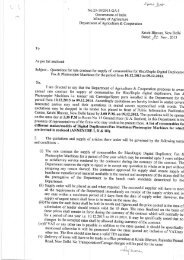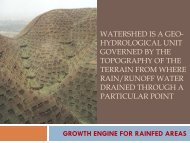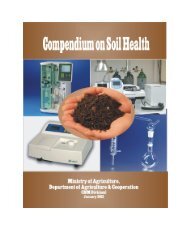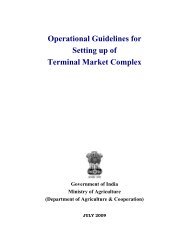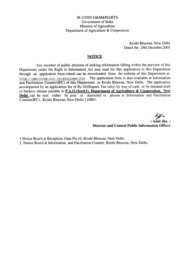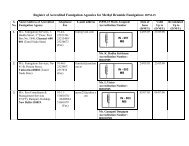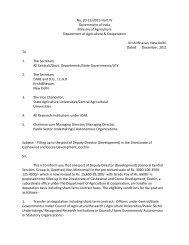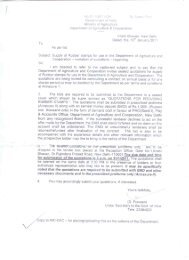Annual Report 2009-2010 - Department of Agriculture & Co-operation
Annual Report 2009-2010 - Department of Agriculture & Co-operation
Annual Report 2009-2010 - Department of Agriculture & Co-operation
Create successful ePaper yourself
Turn your PDF publications into a flip-book with our unique Google optimized e-Paper software.
<strong>Annual</strong> <strong>Report</strong> <strong>2009</strong>-<strong>2010</strong><br />
76<br />
13.5 India is the second largest producer <strong>of</strong><br />
vegetables after China and is a leader in the<br />
production <strong>of</strong> peas. Besides, India occupies the<br />
second position in the production <strong>of</strong> brinjal,<br />
cabbage, cauliflower and onion and third in<br />
potato and tomato in the world. Vegetables that<br />
are produced in abundance are potato, tomato,<br />
brinjal, okra, cucurbits etc.<br />
13.6 India has made noticeable advancement<br />
in the production <strong>of</strong> flowers, particularly cut<br />
flowers, which have a high potential for exports.<br />
Floriculture during 2008-09 covered an area <strong>of</strong><br />
0.17 million hectares with a production <strong>of</strong> 0.98<br />
million metric tonnes <strong>of</strong> loose and 11,362 million<br />
numbers <strong>of</strong> cut flowers.<br />
13.7 India is the largest producer, consumer<br />
and exporter <strong>of</strong> spices and spice products. The<br />
total production <strong>of</strong> spices during 2008-09 was 4.14<br />
million metric tonnes from an area <strong>of</strong> 2.6 million<br />
hectare. The total production <strong>of</strong> plantation crops<br />
during 2008-09 has been 11.33 million metric<br />
tonnes from an area <strong>of</strong> 3.20 million hectare.<br />
13.8 In terms <strong>of</strong> bio-diversity, India is<br />
considered a treasure house <strong>of</strong> valuable<br />
medicinal and aromatic plants, which provide raw<br />
material for formulation <strong>of</strong> indigenous medicines<br />
apart from exports. The Government <strong>of</strong> India has<br />
identified and documented over 9,500 plant<br />
species considering their importance in the<br />
pharmaceutical industry. Of these, about 65<br />
plants have huge and consistent demand in<br />
world trade.<br />
13.9 The development <strong>of</strong> horticulture in the<br />
country is mainly through developmental<br />
programmes <strong>of</strong> the <strong>Department</strong> <strong>of</strong> <strong>Agriculture</strong> &<br />
<strong>Co</strong><strong>operation</strong>. The Schemes under implementation<br />
include (i) National Horticulture<br />
Mission (NHM), (ii) Technology Mission on<br />
Integrated Development <strong>of</strong> Horticulture in the<br />
North Eastern and Himalayan States (TMNE),<br />
Micro Irrigation, National Bamboo Mission,<br />
Schemes <strong>of</strong> the National Horticulture Board<br />
(NHB) and Integrated Development <strong>of</strong> <strong>Co</strong>conut,<br />
including the Technology Mission on <strong>Co</strong>conut<br />
coordinated by the <strong>Co</strong>conut Development Board<br />
(CDB). Besides, a Central Institute <strong>of</strong> Horticulture<br />
(CIH) is functioning at Nagaland for providing<br />
technology & HRD support to the horticulture<br />
sector in the North-Eastern states.<br />
13.10 National Horticulture Mission (NHM): The<br />
<strong>Department</strong> <strong>of</strong> <strong>Agriculture</strong> and <strong>Co</strong><strong>operation</strong>,<br />
Ministry <strong>of</strong> <strong>Agriculture</strong>, has launched NHM, a<br />
centrally sponsored scheme, during the Tenth<br />
Plan, with effect from 2005-06, for the holistic<br />
development <strong>of</strong> the horticulture sector, duly<br />
ensuring horizontal and vertical linkages, with the<br />
active participation <strong>of</strong> all stakeholders. All the<br />
states, and three UTs <strong>of</strong> Andaman and Nicobar<br />
Islands, Puducherry, and Lakshadweep, are<br />
covered under the Mission, except for the eight<br />
North Eastern states including Sikkim and the<br />
states <strong>of</strong> Jammu and Kashmir, Himachal Pradesh,<br />
and Uttarakhand, which have been covered<br />
under the Technology Mission for Integrated<br />
Development <strong>of</strong> Horticulture in the North Eastern<br />
States (TMNE).<br />
13.11 The NHM was launched during 2005-06<br />
with the objective <strong>of</strong> providing holistic growth<br />
to the horticulture sector through an area-based,<br />
regionally differentiated strategy. The supply <strong>of</strong><br />
quality planting material through nurseries and<br />
tissue culture units, production and productivity<br />
improvement programmes, technology<br />
promotion, extension, post-harvest<br />
management, and marketing, in consonance<br />
with the comparative advantages <strong>of</strong> each state/<br />
region and their diverse agro-climatic conditions,<br />
are the major programmes <strong>of</strong> the scheme.<br />
13.12 Physical Progress: A summary detail <strong>of</strong><br />
the progress achieved is given in table 13.1 :



